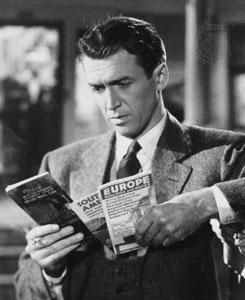For years now, watching “It’s A Wonderful Life” has been part of our family’s tradition. It started when I was a teenager and lived at home with my parents and brother, Glen. Even on occasion now, if we have an early snowfall prior to Christmas, my father will call and say, “It’s time for ‘It’s A Wonderful Life.’” I’m happy to report that the tradition of incorporating this film into my family’s holiday tradition happens in my own home now, as my husband, daughter, son and I all snuggled up together last Saturday night and indulged in its brilliance.
There’s a lot of Christmas spirit in this house, but it kicks off when we watch this “wonderful” film.
It transcends generations. Whether you will watch it for the first time this year or have been watching it for years, there’s something so special about a film that makes us reconsider and reflect upon our own lives. As we live vicariously through George, Mary, Clarence, Billy, and mean Mr. Potter, we are reminded that maybe we don’t have it so bad, after all. Maybe what we have, instead, is a very wonderful life, even when things look bleak and the future is unknown.
When Clarence writes in the Tom Sawyer book that falls onto the massive pile of money that’s been collected on the table as friends, neighbors, and family gather to support and pay tribute to George Bailey, we understand the scope of the lesson. Clarence writes, “No man is a failure who has friends.” It’s so sentimental that one can’t help but tear up. Additionally, when Harry Bailey flies through the blizzard and arrives, snow covered, to be there for George and toasts his brother saying, “Here’s to my big brother, George…the richest man in town,” we have a play on words; Harry is referring to Mr. Potter’s inability to be truly “rich,” and that instead, his brother is “rich” in the ways that truly count. It’s at this moment that we see George recognize the value and worth of his own life—and how his life has touched others.

Which leads us to another lesson the film offers as it questions us: If we don’t pursue the dreams we dream, and our life takes another course of direction instead, do we no longer live a life worth living? Stewart “sees” the answers to this question himself, with the help of Clarence. And an even deeper question is answered as well: Would life really have been better if we had never been born? These are some deep, thought-provoking questions that make us pause, look, listen, and ponder.
My children may be a little young to fully comprehend the magnitude of Frank Capra’s classic film, but when my son told me it’s absolutely his favorite Christmas movie, I knew he understood its meaning and its tenderness.
And that’s the wonderful thing about “It’s A Wonderful Life”—that an eleven-year-old boy in 2011 can relate to this black and white film, grasp it, and understand why it’s touching, meaningful, and a must-see holiday classic. I hope when he is grown and has a family of his own, it makes its way into his holiday film library.

